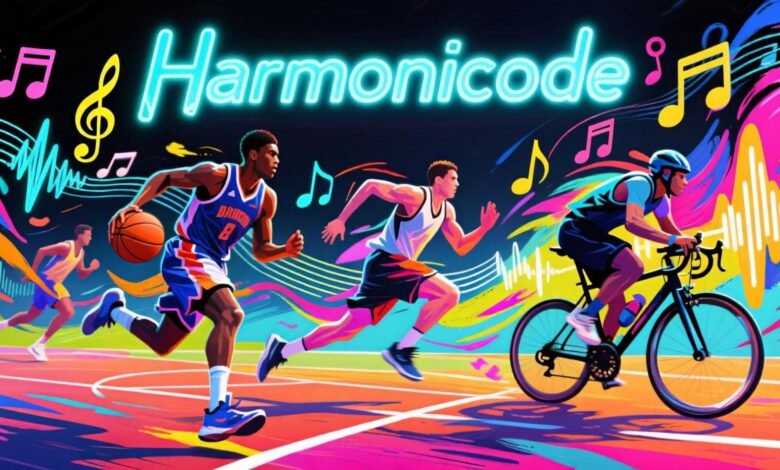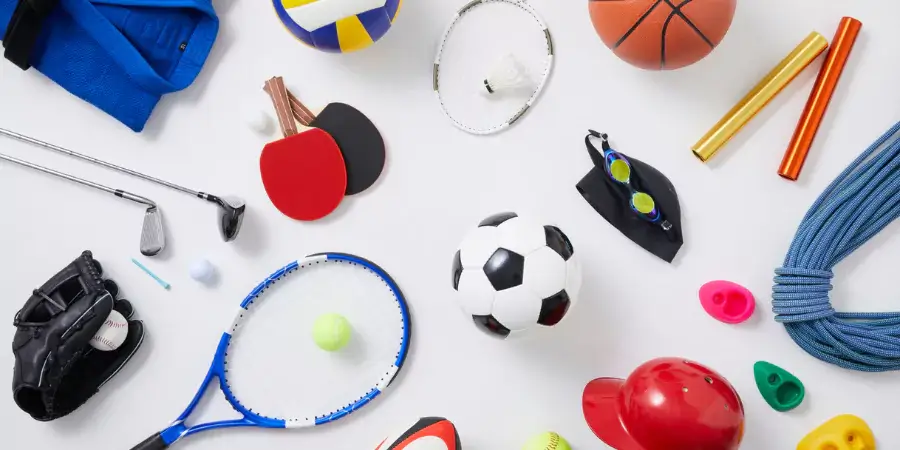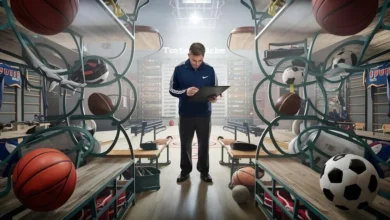What Is Harmonicode Sport? A Beginner’s Guide to the Next Fitness Trend

Harmonicode Sport Fitness keeps evolving. From HIIT to yoga to virtual reality workouts, people are always looking for new ways to stay motivated, improve both body and mind, and make exercise more fun. One of the newer ideas catching attention is Harmonicode Sport It blends rhythm, athletic movement, music, technology, and mental challenge. But what exactly is it, and should you try it? Let’s dig in.
What Is Harmonicode Sport?
- Definition: Harmonicode Sport (also called Sport Harmonicode, Harmonicode Sports, etc.) is an emerging fitness/sport concept that merges physical activity with rhythmic or musical cues and often integrates cognitive elements.
- Core idea: The idea is to synchronize one’s movements (dance, athletic drills, strength or agility exercises, obstacle‑course‑style tasks) with rhythms or musical beats or cues. Sometimes there are devices or apps giving auditory/visual cues to guide timing. Some versions also include coding/puzzle or reaction‑based tasks.
- Why “Harmonicode”? It seems to come from “harmony” + “code” (or rhythmic code): the “code” being sequences of beats or signals, which the athlete must interpret, synchronize with, respond to.
So Harmonicode Sport is more than just moving to music; it is often about precision, timing, mental engagement, sometimes technology, feedback, and often creativity.
The Key Components What Makes Harmonicode Sport Different
Here are some of the distinctive features:
| Component | Description |
|---|---|
| Rhythmic / Musical Synchronization | Movements timed to music, beats, or rhythm cues. This may include matching pace, tempo, timing, movement transitions in choreography. |
| Physical Fitness & Athleticism | Not just dance many versions include agility work, cardiovascular endurance, strength, flexibility. Bodies must move in precise, coordinated ways. |
| Cognitive / Mental Challenge | Because you need to respond in time, remember rhythmic sequences, adapt to unexpected changes. In some variants there are puzzle‑coding tasks, reaction tasks, decision‑making. |
| Technology & Feedback Systems | Wearable sensors, motion tracking, maybe apps or devices that record rhythm accuracy or movement precision. Some proposals include AR/VR environments, real‑time feedback. |
| Games / Variability & Creativity | Often includes optional gameplay, team or solo modes, levels of difficulty, creative routines or freestyle components. |
| Mind‑Body / Emotional / Social Elements | Because music influences mood, motivation; the social aspect of doing rhythmic group workouts; stress relief; enjoyment; community building. |
How It Works A Breakdown for Beginners
If you’re interested in trying Harmonicode Sport, here’s what a typical session or program might look like, and what you’ll need.
What You Might Need
- Good pair of athletic shoes and comfortable clothing
- Music source (headphones, speakers, or integrated in the class or system)
- If available: a device/app or wearable that gives cues (audio/visual) and feedback (timing, rhythm, accuracy)
- Space to move safely (studio, gym, outdoor)
- Optional: group class or partner experiences, though solo is possible
Typical Structure
- Warm-Up: Gentle movements, getting in tune with rhythm/melody, perhaps slow dance‑movement or stretching with beat.
- Core Routine: A sequence of exercises aligned with rhythm. Could be choreographed movements, interval drills, rhythmic sequences, possibly reaction tasks (respond to a cue or beat change).
- Cognitive / Timing Challenges: Might include remembering certain patterns, switching rhythm, adapting to changing tempo. In advanced forms, maybe a coding/puzzle component mixed in.
- Cool Down / Stretch: Slower rhythmic movement, breathing, reflection on the session.
- Feedback / Tracking: If using tech, review performance: how well you matched the rhythm, your reaction times, etc.
Difficulty Levels
Beginners can start with simple beat‑matching and less intense physical demands. As you progress, complexity increases: more challenging choreography, faster tempos, shorter intervals, more abrupt cue changes, or adding cognitive tasks.
Benefits of Harmonicode Sport
Here are the claimed or observed benefits from available sources:
- Improved Physical Fitness: Cardiovascular health, strength, flexibility, endurance. Because the workouts tend to combine movement types.
- Better Coordination & Timing: Synchronizing movement with rhythm improves motor skills, balance, agility.
- Cognitive Enhancements: Improved focus, reaction time, mental agility from having to follow cues, adapt, remember patterns.
- Motivation & Enjoyment: Music makes exercise more fun, can reduce perceived effort, improve adherence to workouts.
- Stress Reduction & Emotional Well‑Being: Music + movement has positive effects on mood, anxiety relief.
- Social Connection: Group classes, community, shared experiences can create camaraderie.
Potential Drawbacks or Things to Be Careful About
No trend is perfect. Here are possible downsides:
- Risk of Overload / Injury: If movements are complex or fast, there’s a risk if form is ignored, or rest/cool down is skipped.
- Cost / Access: Classes or equipment (wearables, apps, sensors) might be expensive or not widely available yet.
- Tech Dependency: If you rely on tech for cues or feedback, what happens if it malfunctions or is unavailable? Also concern with privacy/data if wearables/apps collect personal metrics.
- Learning Curve: If rhythm elements or cognitive‑task components are new to you, might feel frustrating or difficult at first.
- Music Preference: If you don’t like the music used, or find beat matching constraining, it might reduce your enjoyment.
Who Should Try Harmonicode Sport And Who Might Skip
Ideal For
- People looking for a fun, music‑driven workout rather than traditional gym routines.
- Those who enjoy dance, rhythm, coordination, or artistic expression combined with physical fitness.
- Individuals wanting cognitive stimulation with physical exercise.
- People who like group classes or community fitness experiences.
- Athletes interested in improving coordination, timing, agility.
Maybe Avoid / Take Caution
- If you have certain injuries, mobility limitations, or conditions where rhythm movement or sudden changes might cause strain. Always check with a medical professional.
- If you dislike structured cues or music‑based exercise.
- If you have concerns about using wearables or apps that track your data.
Real‑World Examples & Current Status
- Some fitness studios have begun offering classes with rhythmic‑movement + music + sensory cues.
- Tech startups are developing wearables, apps, sensors to facilitate these kinds of workouts.
- Amateur / enthusiast communities are forming for people exploring “sport + music + rhythm” concepts.
- But as of 2025, Harmonicode Sport is still relatively new; not yet mainstream, infrastructure and formal organized competitions are limited.

Should You Use Harmonicode Sport?
Based on what we know now, here are considerations to help you decide:
- If you want a workout that is more engaging, creative, and fun than standard cardio or weightlifting, Harmonicode Sport could be a great match.
- If you care about combining mental and physical fitness – not just sweat, but brain engagement too – then this trend seems promising.
- If you have regular access to classes or good tech/equipment, you can get more from it. But if not, some versions might be limited.
- If your goal is maximal performance (e.g. for competitive sport), you may still need to combine Harmonicode with more specific training (strength, endurance, skill drills) rather than rely on it alone.
- Always start gradual, ensure good technique, warm up, listen to your body, and possibly consult a trainer, especially when adding rhythm/cognitive challenges.
How to Get Started
If you want to try it, here’s a simple path:
- Explore classes: See if there are fitness studios near you offering classes with rhythm + movement (dance cardio, rhythmic HIIT, etc.).
- Find good music / playlist: Choose songs with clear, strong beats. Start with slower BPM, then increase.
- Use apps or tech: If available, use apps that deliver rhythmic cues or follow‑along movement‑to‑beat workouts. Even YouTube videos can help.
- Practice rhythm & coordination: Start with simple sync movements (e.g. stepping, clapping, lunges to beat) before trying more complex patterns.
- Incorporate into your routine: 1‑2 times a week to start, then perhaps more. Mix with other workouts.
- Gather feedback: If using tech, review metrics; if not, just reflect: How did you feel? Was your endurance improving? Did coordination improve?
Conclusion
Harmonicode Sport is an exciting, multi‑dimensional fitness trend that bridges physical activity, musical rhythm, cognitive tasks, and often technology. It represents a fresh way to engage in fitness: one that appeals not just to the body but to the mind and emotions as well. If you enjoy movement, music, challenge, and variety, Harmonicode Sport is very much worth exploring. While the infrastructure is still growing and some versions are experimental, the core idea syncing rhythm + physical movement + mental engagement has proven benefits and feels like a likely direction for future fitness trends.
